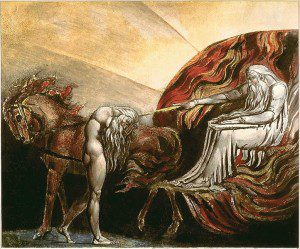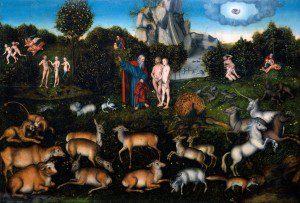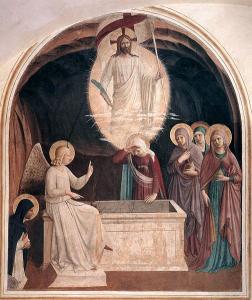 The next chapter of Greg Cootsona’s new book (Mere Science and Christian Faith: Bridging the Divide with Emerging Adults) broaches the subject of Adam and Eve. Were Adam and Eve historical individuals, the progenitors of the entire human race. This is probably the single most contentious question within the church when it comes to mainstream science and Christian faith. It is also a question where dogmatic pronouncements can sometimes close the door for evangelism. This is particularly true among scientifically inclined emerging adults – those in Greg’s primary target audience.
The next chapter of Greg Cootsona’s new book (Mere Science and Christian Faith: Bridging the Divide with Emerging Adults) broaches the subject of Adam and Eve. Were Adam and Eve historical individuals, the progenitors of the entire human race. This is probably the single most contentious question within the church when it comes to mainstream science and Christian faith. It is also a question where dogmatic pronouncements can sometimes close the door for evangelism. This is particularly true among scientifically inclined emerging adults – those in Greg’s primary target audience.
Greg outlines three approaches to the question of Adam and Eve.
(1) A historical couple living something like 6000 years ago (perhaps a little longer) specially created by God from the dust or clay of the earth. This approach has a long history in the church, but runs seriously afoul of mainstream science on many levels and, in fact, raises a few biblical conundrums as well – most significantly the question of wives for Cain and Seth and the population that Cain (Adam’s firstborn) feared. Greg is convinced that this option isn’t true.
(3) At the other end of the spectrum we have the suggestion that Adam and Eve are paradigmatic of the human condition. In the Problem of Pain CS Lewis outlined such a scenario. The reality of a “fall” of some sort is maintained as is a God implanted divine image, but the story of Adam and Eve relates this event, not the story of two unique (and sole) persons. There is some biblical support for this approach in the form of the story of Adam and Eve. Most significantly, in the early parts of the story adam is not a proper name, but “the man” or “the earthling”. His wife is named “life.” These names are consistent with a paradigmatic, typological, and/or archetypal view of Adam and Eve.
 (2) Between the two positions above we have a range of views that maintain Adam and Eve as historical individuals while realizing that the issues raised by biblical evidence and mainstream science must also be taken into account. John Walton, Tim Keller, NT Wright, C. John Collins, Derek Kidner, John Stott, and many others fall (or fell) into this camp.
(2) Between the two positions above we have a range of views that maintain Adam and Eve as historical individuals while realizing that the issues raised by biblical evidence and mainstream science must also be taken into account. John Walton, Tim Keller, NT Wright, C. John Collins, Derek Kidner, John Stott, and many others fall (or fell) into this camp.
Greg points to his friend Gary Fugle (Laying Down Arms to Heal the Creation-Evolution Divide, an excellent book I blogged through several years back) to summarize two possible scenarios for a historical pair: “Adam was singly taken aside by God from physically evolved humans and the image was divinely imparted to him” or God “revealed himself in a special way to two individuals or a group of humans and this knowledge of God spread outward to other people who would hear.” (p. 89) Derek Kidner and John Stott (in his Romans commentary, referring back to Kidner’s Genesis commentary) suggest a federal headship of Adam. Others have looked at the election of Israel and suggested that Adam and Eve could have been selected as priests, representatives, before God.
Position (2) in all its variants leads to the observation that there is a picking and choosing of elements to be taken literally – making those elements fit within an overall scenario. This is a real question. Greg ends … “as a pastor commented in one of the monthly science and religion meetings I host, “Why interpret some components of Genesis 1-3 literally but not others?” (p. 89)
It is not entirely clear where Greg lands in the range of positions (2) and (3) – but some things are clear. We have to take Paul seriously, especially Romans 5:12-21 and 1 Corinthians 15:21-22. I think he is giving part of his view when he notes “Adam and Eve’s fall initiated a cosmic change. It defines an old age or a world that is passing away (1 Corinthians 7:31). With Christ a new world (or age) has begun. Christians from Paul’s time until today are caught between these two worlds, between their power.” (p. 91)
 Let’s Keep Our Eyes on Jesus. The key idea in Paul is not Adam, it is Christ. “Christ is the focus of Paul’s letters – and indeed the whole New Testament – not Adam.“(p. 92) How do we decide within the spectrum of views on Adam? “To answer that last question, let me repeat: the center of our faith is Christ, not Adam.” (p. 93) and then “as Christians we believe that redemption comes through the grace of Jesus Christ, received by faith. This is the universal answer for the universality of sin.” (p. 94) In the early church (second and third centuries) the origin of sin was not a particularly significant question, redemption through Christ was. If we keep our focus on Christ we realize that the question of Adam is a secondary issue. Although it may be an important question, it is a debate among orthodox Christians not a marker of heresy.
Let’s Keep Our Eyes on Jesus. The key idea in Paul is not Adam, it is Christ. “Christ is the focus of Paul’s letters – and indeed the whole New Testament – not Adam.“(p. 92) How do we decide within the spectrum of views on Adam? “To answer that last question, let me repeat: the center of our faith is Christ, not Adam.” (p. 93) and then “as Christians we believe that redemption comes through the grace of Jesus Christ, received by faith. This is the universal answer for the universality of sin.” (p. 94) In the early church (second and third centuries) the origin of sin was not a particularly significant question, redemption through Christ was. If we keep our focus on Christ we realize that the question of Adam is a secondary issue. Although it may be an important question, it is a debate among orthodox Christians not a marker of heresy.
Greg concludes the chapter with five reflections on biblical interpretation – ones to apply when it comes to the question of Adam and to many other issues. (pp. 96-98)
(1) We hold to the Bible because there we find relationship with God through Jesus Christ. This is the most important of the five. Our faith is based on relationship and the foundation is God not Scripture. However, important Scripture is as a lamp to our feet and light to our path it is not the foundation or path itself.
(2) Although we seek integration, we need to interpret Scripture with a sufficient dose of independence between science and faith when necessary. “When Psalms 8 and 19 lead us to consider the heavens and the glory of humankind, they don’t tell us how to use a telescope, interpret the mathematics of physics or understand comparative anatomy. These are all human endeavors complementary to the study of Scripture.” (p. 97)
(3) The interests of the interpreter are critical to the task of interpretation. This doesn’t mean that we can shape the Scripture to fit preference – but that different perspectives will highlight different features.
(4) Science is not the sole arbiter of truth.
(5) Our biblical interpretation is about learning to live within the narrative of the Scripture. “This is letting God’s story become our story.” (p. 98) This really couples back to the first principle above. We hold to the Bible to find relationship, we look to the Bible to let God’s story become ours, and we keep our eyes on Jesus as the center of our faith and the pinnacle of God’s story in this world even as we look to the age to come.
The question of Adam is a significant one. It is worth much thought and discussion. No, there is not a neat solution at this time. However, Adam is not the center of our faith. We should not allow this debate and discussion to alienate fellow believers or non-Christians who may be otherwise open to consideration of the gospel.
Thoughts?
If you wish to contact me directly you may do so at rjs4mail[at]att.net.
If interested you can subscribe to a full text feed of my posts at Musings on Science and Theology.











